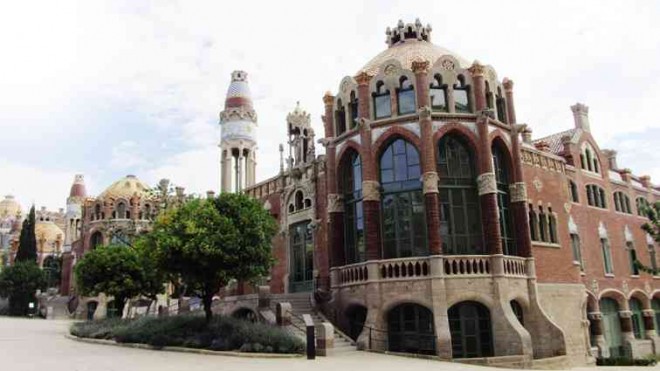
Barcelona. The Spanish sun, the Medditernean sea, the Catalan artistry, and home to the illustrious architect Antoni Gaudi.
This was our second visit to this former Olympic city, and revisiting the masterpieces of Barcelona’s most famous son still astounded. There were the Gaudi classics such as the whimsically capricious and still unfinished towers of La Sagrada Familia Cathderal; the dazzling gingerbread-inspired eye-candy of a park that is Parc Guell, and the equally famous houses of Casa Battlo and La Pederera.
Indeed, it seemed there was no escaping Gaudi in Barcelona! But as we discovered on this comeback, there was more to the Catalan Art Nouveau style, referred to as Modernisme among Barcelona folks, than the famous works of Gaudi.
A medical facility normally would not be on top of anyone’s place to visit, but just a few blocks from La Sagrada Familia is Barcelona’s most remarkable Modernisme-style complex, the Sant Pau Art Noveau site. This is the masterpiece of another of Barcelona’s brilliant sons, Lluís Domènech i Montaner, who was a contemporary of Gaudi.
While less famous than Gaudi, Montaner nonetheless was just as prolific and talented. He left his architectural mark in the Barcelona landscape, including this medical complex and another Barcelona landmark, Palau Música Catalana, both inscribed on Unesco’s World Heritage List.
City within a city
The 19th century was a time of great change and prosperity for Barcelona. The city, having just hosted the Universal Exposition in 1888, turned into a stage where architecture played a major role as an indicator of social status for the city’s flourishing bourgeoisie.
Art Noveau was then making headway in Europe, and architects embraced this new style with its floral decorations, rich sculptural and iron works, undulating forms, stained glass and colorful ceramic details. In Barcelona in particular, this design also flowered as an assertion of the regional Catalan identity.
Built between 1902 and 1930, and officially known as Hospital de la Santa Creu i Sant Pau, this “city within a city” in the famous 19th-century Eixample district bears witness to a highly significant part of the evolution of medicine in the history of Barcelona.
The origins of the institution date back to 1401, but by the early 20th century, the old Gothic-style buildings of the institution were showing signs of fatigue. Work began on this facility to meet the health needs of Barcelona at the height of its new industrial demographic growth.
Enter Lluís Domènech i Montaner, who was commissioned by benefactor Pau Gil to create what would eventually become the largest Art Nouveau complex in Europe.
Symbolic site
The site of Sant Pau has symbolic connotations. Montaner based the ground plan of the hospital complex on two axes, one vertical and the other horizontal, which together formed a cross that represented the emblem of the institution.
One enters through the turreted former Administrative Building, which looks more like a monastery or a train station. A well-designed interpretive center provides a historical and architectural overview of the complex.
Symmetry is the main theme of Sant Pau. There are 27 (16 in the Art Nouveau style) pavilions that are arranged along two main north/south and east/west thoroughfares that are connected by one long underground pedestrian gallery. One has to go through this to go up to the main square inside the complex.
What greeted us upon entry to the main square was something we did not quite expect: a sudden profusion of flamboyant colors, sculptural ornamentation, whimsical towers and verdant gardens that looked straight out of a child’s fairytale or coloring book.
Then it hit us: This was the genius of Montaner. In designing Sant Pau, he built isolated pavilions, each assigned to a specific medical specialty and linked to the others by means of one kilometer of underground tunnel that also acted as utility ducts.
Immediately we were drawn to the shimmering ceramic details that endowed all the buildings with spectacular notes of luminosity and vitality.
Symbolic images such as Sant Jordi and Sant Marti, the defender of the poor, were more than just artistic adornments but also expressed Barcelona’s identity as a Catalan city.
Peace and luminosity
Details such as delicate flowers embedded on brick walls, niches, floral crowns, reliefs and carved capitals all exhibited mastery in stonemasonry. Inside the buildings, green ceramic colors combined harmoniously with walls and ceilings to transmit a feeling of peace and luminosity for the ailing patients.
Flora and fauna ornamental elements exuded regeneration, healing, positive over negative, and life over death. And they were easy to keep clean, too.
In between pavilions, Montaner also integrated nature through pocket gardens that created a cheerful and optimistic atmosphere. In doing so, he hoped to help alleviate the pain and suffering of the patients, thus contributing to their quick recovery.
The garden’s function went beyond aesthetics for they also purified the air from toxic gasses, preserved humidity and prevented desiccation. The central avenue was lined with orange trees which provided warmth in winter and shade in summer.
This hospital-garden concept was way ahead of its time when open-air areas for patient’s well-being were regarded as unnecessary.
Sant Pau’s medical facilities have since moved to newer facilities in 2009. The 20th-century complex has found new life as a medical research center, historical archive, and architectural tourist draw as part of Barcelona’s Ruta del Modernisme, the cultural route that takes visitors through the city’s iconic Art Nouveau heritage buildings.
The transformation of Sant Pau is a lasting tribute to the vision and creativity of a great architect. From a confined health institution to a public cultural space, Sant Pau has, indeed, come full circle and now opens its doors for visitors to admire.